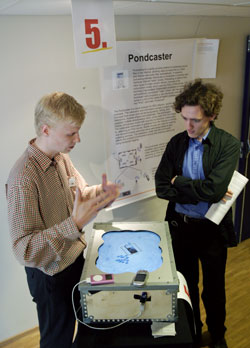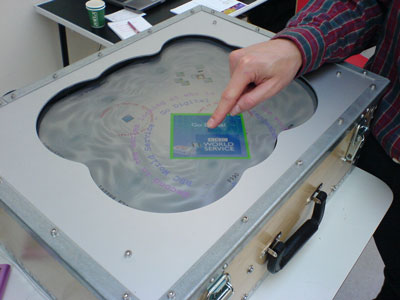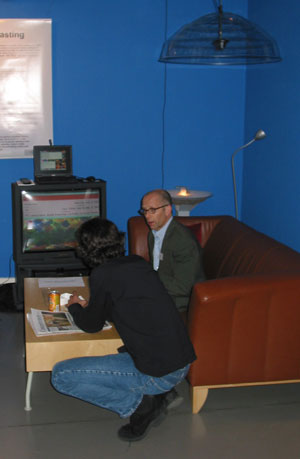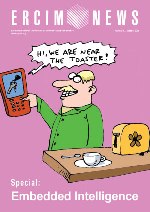by Emmanuel Frécon and Pär Hansson
Podcasting has taken the world by storm and become a mass phenomenon in less than a year. The core activities of podcast consumers, namely selecting broadcast sources and listening to portable media players, are solitary experiences. The Pondcaster project seeks to take podcasting a step further by encouraging group discovery and shared listening through a combination of interactive tabletop displays and personalised ambient listening stations.
Podcast was elected Word of the Year 2005 by the editors of the New Oxford American Dictionary and is now officially defined as "a digital recording of a radio broadcast or similar programme, made available on the internet for downloading to a personal audio player". In its current form, podcasting is a way for individuals and radio stations to broadcast shows by making them accessible as digital audio (and now also video) files over the internet. Listeners decide the type of programme they wish to hear and automatically have it downloaded so they can listen later, off-line, on portable media players such as the Apple iPod, which gave its name to the phenomenon.
Both the process of selecting shows to subscribe to for automatic synchronisation and that of listening at a later time are solitary experiences. While the various communication media offered by the internet can help in discovering and selecting shows, there are few ways for a co-located group to interactively share content and experience from a given set of already-loaded media players. This is a problem, especially as the venue of media players has been criticised as an invention that increases personal isolation in traditionally public or semi-public spaces such as streets, transport systems or even homes.

The SICS Pondcaster project addresses these problems and proposes a system that radically steps away from current podcast selection and consumption by supporting shared experiences. The Pondcaster system comprises a tabletop interactive artefact, which uses a pond environment as its metaphor, and any number of ambient listening stations placed in the environment to allow group listening, thus, bringing back the social aspects of radio listening from the early days of radio. The tabletop artefact builds on devices that can be found in every listener's pocket, such as media players and possibly mobile phones, and features unencumbered interaction via a touch screen.

The tabletop artefact acts as a sink for the podcast content of the users' media players, providing a snapshot of their current choices and podcast tastes. On physical connection, the content of any media player is automatically shown, using an animated aquatic metaphor. The pond shows groups of similar content as animated shoals of creatures, where each creature represents a podcast show. To avoid clutter, the metaphor is self-cleaning, whereby old, unused shoals slowly sink to the bottom of the virtual pond. By interacting with the creatures representing podcast shows, users can access show details and start listening, which favours collaboration and discovery of new sources. The artefact is also linked to a phone number and any user can send an SMS containing the words of a query. On reception, acting as an internet podcast search engine, the artefact will display matching podcast shows as a new shoal. These shows are typically not present on any connected media player, which again favours discovery of new shows. Finally, the artefact keeps track of bluetooth-enabled mobile phones in its close vicinity. Users can express their intention to listen further to newly discovered shows by dragging specific creatures to a representation of their phone.
The associations between shows and mobile phones will be remembered by the system. At a later time, users are able to listen to the chosen shows at public radio-like terminals. Users within the bluetooth vicinity of such a terminal will be recognised and their selections retrieved and played using a queue system. The setting encourages socialising, discussion and mobility since it keeps track of listening state across a set of listening stations for a given user.

The Pondcaster is based on existing internet technologies and because the system uses bluetooth tagging, no data is ever moved to mobile phones and media players. Subscriptions and preferences are kept on the Pondcaster and made available for further access by media players and Web browsers. As such, the artefact forms the premises of a personalised podcast aggregator.
Link:
http://www.sics.se/ice/projects/pondcaster
Please contact:
Emmanuel Frécon, SICS, Sweden
Tel: +46 8 6331500
E-mail: emmanuel![]() sics.se
sics.se










